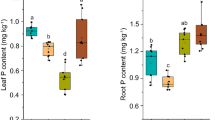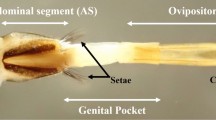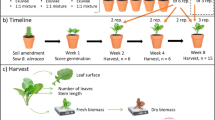Summary
The concentration of nitrogen in the foliage of Eucalyptus blakelyi strongly influenced both the total number of eggs laid and the rate of production of eggs by female Paropsis atomaria, a chrysomelid defoliator of Eucalyptus spp. Females feeding on foliage with low levels of nitrogen laid fewer eggs at a slower rate than those feeding on foliage with high levels of nitrogen. an increase from 1.5% to 4.0% of nitrogen in the foliage increased the total number of eggs laid by 500% and the rate of production of eggs by 400%. The rate at which females fed was not influenced by the concentration of nitrogen in their food. The viability of their eggs was negatively related with the concentration of nitrogen in the diet. Females feeding on foliage with low levels of nitrogen laid eggs which were significantly heavier than those of females on high nitrogen diets. Females on high nitrogen survived significantly longer than those on low nitrogen. In the field the concentration of nitrogen in the foliage of E. blakelyi occurs over a range shown to dramatically influence both the fecundity and rate of production of eggs of P. atomaria. Nitrogen may therefore play an important role in the population dynamics of this beetle.
Similar content being viewed by others
References
Amman GD, Cole WE (1983) Mountain pine beetle dynamics in lodgepole pine forests. II. Populations dynamics. USDA For Ser Gen Tech Rep INT-145. 59 pp
Carne PB (1966) Ecological characteristics of the eucalypt-defoliating chrysomelid Paropsis atomaria 01. Aust J Zool 14:647–672
Hilliard RA, Keeley LL (1985) The effects of dietary nitrogen on reproductive development in the female boll weevil, Anthonomus grandis. Physiol Ent 9:165–174
Hough JA, Pimentel D (1978) Influence of host foliage on development, survival, and fecundity of the gypsy moth. Environ Ent 7:97–102
Ingestad T (1971) A definition of optimum nutrient requirements in birch seedlings. II. Physiol Plant 27:118–125
Marascuilo LA (1971) Statistical methods for behavioral science research. McGraw-Hill, New York, p 578
Mattson WJ (1980) Herbivory in relation to plant nitrogen content. Ann Rev Ecol Syst 11:119–161
McNeill S (1973) The dynamics of a population of Leptopterna dolabrata (Heteroptera: Miridae) in relation to its food resources. J Anim Ecol 42:495–507
McNeill S, Southwood TRE (1979) The role of nitrogen in the development of insect/plant relationships. In: Harborne JB (ed) Biochemical aspects of plant and animal coevolution. Phyto Chem Soc Eur Symp Ser 15:77–98
Miller CA (1957) A technique for estimating the fecundity of natural populations of the spruce budworm. Can J Zool 35:1–13
Murphy DD, Launer AE, Ehrlich PR (1983) The role of adult feeding in egg production and population dynamics of the checkerspot butterfly Euphydrias editha. Oecologia (Berlin) 56:257–263
Myers JA, Post BJ (1981) Plant nitrogen and fluctuations of insect populations: A test with the cinnabar moth-tansey ragwort system. Oecologia (Berlin) 48:151–156
Ohmart CP, Stewart LG (1985) Use of a desk-top microcomputer for measuring insect defoliation on leaves of broad-leaved trees. Aust For Res 15(2) (in press)
Ohmart CP, Stewart LG, Thomas JR (1983) Leaf consumption by insects in three Eucalyptus forest types in southeastern Australia and their role in short-term nutrient cycling. Oecologia (Berlin) 59:322–330
Ohmart CP, Stewart LG, Thomas JR (1985) Effects of food quality, particularly nitrogen concentrations, of Eucalyptus blakelyi foliage on the growth of Paropsis atomaria larvae (Coleoptera: Chrysomelidae). Oecologia (Berlin) 65:543–549
Palmer WA, Bay DE (1983) Effects of intraspecific competition and nitrogen content of manure on pupal weight, survival, and reproductive potential of the horn fly, Haematobia irritans irritans (L.) Prot Ecol 5:153–160
van Emden HF (1966) Studies on the relations of insects and host plant. III. A comparison of the reproductives of Brevicoryne brassicae and Myzus persicae (Hemiptera: Aphididae) on brussel sprout plants supplied with different rates of nitrogen and potassium. Ent exp Appl 9:444–460
White TCR (1978) The importance of a relative shortage of food in animal ecology. Oecologia (Berlin) 33:71–86
White TCR (1984) The abundance of invertebrate herbivores in relation to the availability of nitrogen in stressed food plants. Oecologia (Berlin) 63:90–105
Author information
Authors and Affiliations
Rights and permissions
About this article
Cite this article
Ohmart, C.P., Stewart, L.G. & Thomas, J.R. Effects of nitrogen concentrations of Eucalyptus blakelyi foliage on the fecundity of Paropsis atomaria (Coleoptera: Chrysomelidae). Oecologia 68, 41–44 (1985). https://doi.org/10.1007/BF00379471
Received:
Issue Date:
DOI: https://doi.org/10.1007/BF00379471




